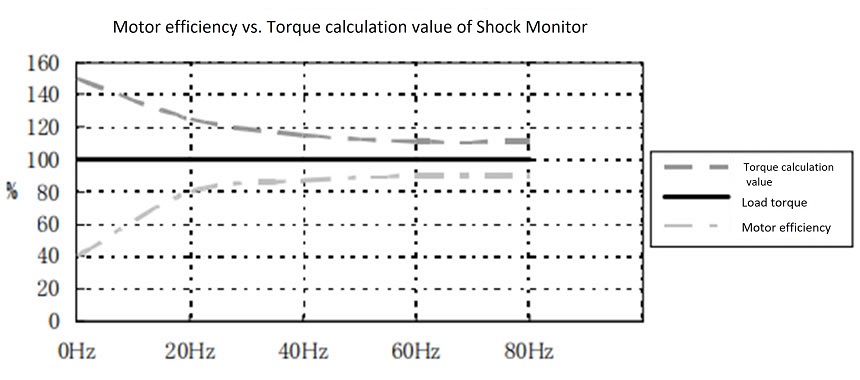Technical Data Electrical controllers Shock Monitor
Torque monitoring
For basic type, when parameter 19: POWER/TORQUE is set to (2) TORQUE, the monitoring can be performed using a torque calculation value.
The torque monitoring compares a torque calculation value (%) with a preset overload level (specified as % of the torque).
This function is especially useful when the frequency is arbitrarily changed by inverter operation.
1. Torque calculation formula
For torque monitoring, the Shock Monitor calculates a torque value using the following formula and three elements: Detected electric power (%), Frequency of the motor supply voltage, and Estimated motor copper loss (%).
(The torque at 60 Hz is assumed as 100%. )
Torque calculation value (%) = (Detected electric power - Estimated motor copper loss ) × 60 Frequency
2. Differences between the electric power monitoring and torque monitoring during inverter operation
When an inverter is used for variable speed operation, setting the frequency to half makes both of the work and motor current consumption be about half, even when the load torque is constant.
In case of power monitoring, when you set the frequency to half, it is difficult to detect overload accurately unless you also set the overload detection level to half by using the multi-step switching function.
On the contrary, torque monitoring eliminates the need for changing the overload detection level by dividing the halved detected power with the frequency of the motor supply voltage read with the Shock Monitor. This function is especially useful when the motor is operated with stepless, arbitrary frequencies.
3. Notes on torque monitoring
- ・The torque calculation value is based on the rated torque at 60 Hz.
- ・In order to minimize an error in the torque calculation value, the calculation is adjusted by subtracting an estimated motor copper loss. Note, however, that when you use low frequency (about 20 Hz or less), the detected electric power in the above formula as well as the frequency in the denominator become smaller, which makes the error far greater.
4. Torque calculation value for various frequencies
Since the motor efficiency is extremely low at lower frequencies, the error in the torque calculation value of the Shock Monitor becomes greater as shown in the graph below.

As the graph shows, when torque monitoring is performed at low frequencies, the torque calculation value becomes larger, resulting in frequent activation of the output relay.
If you need to use 20 Hz or lower frequencies for positioning or other operation, it is recommended to fix the low-speed frequency as well as to use the multi-step setting.

